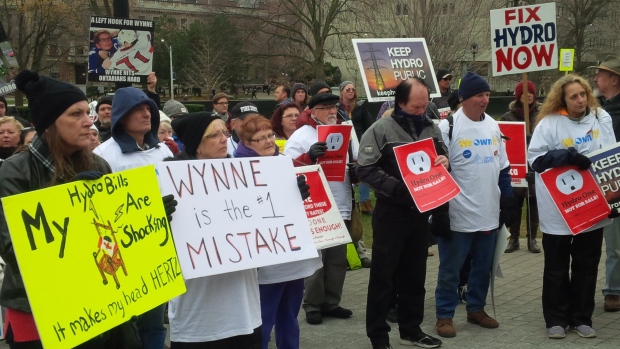By Mike Crawley, CBC News Posted: Nov 24, 2016 10:57 AM ET Last Updated: Nov 24, 2016 10:57 AM ET
Demonstrators unhappy with the price of electricity protest outside the Ontario Legislature on Wednesday. (Mike Crawley/CBC)
Smart meters — the $2-billion project to switch millions of Ontario households and small businesses to a differential hydro pricing scheme — are failing to accomplish the chief objective of curtailing electricity demand at peak periods, according to growing research.
The latest figures from the province’s energy agencies indicate residential consumers are burning nearly as much hydro at peak periods as they were before smart meters were rolled out.
As well, cost of electricity at peak periods has soared 82 per cent since 2010, when smart meters and “time of use” pricing started becoming the norm for Ontario households.
- Why hydro prices are so high in Ontario
- ‘My mistake’: Kathleen Wynne takes blame for unaffordable hydro bills
With many people in Ontario saying peak pricing is one of the reasons electricity bills are rising, the government of Kathleen Wynne is being forced to re-examine time-of-use pricing to meet its pledge of making hydro more affordable.
“Everything is on the table,” Energy Minister Glenn Thibeault answered when I asked him at Queen’s Park on Wednesday about changing the time-of-use program.
”There are solutions that are being proposed out there and it’s my job … to find ways to continue to have downward pressure on rates,” Thibeault said. “It’s a difficult process to look at, but I know it’s one that I’m happy to tackle.”
A series of reports examining Ontario’s electricity system indicate the smart meter project and time-of-use pricing are neither significantly reducing peak hydro demand nor persuading consumers to shift their usage to off-peak periods. (Canadian Press)
The province’s rationale behind smart meters and peak-period pricing was “to give consumers incentives and opportunities to reduce their electricity bills by shifting their time of electricity use.”
But consumers don’t appear to be biting.
“The current time-of-use pricing structure has not provided sufficient incentives for consumers to shift and/or reduce use,” concludes a recent review conducted by the Brattle Group consulting firm for the Independent Electricity System Operator.
It’s the latest report indicating the smart metering initiative is failing to have a significant impact on demand. In addition:
- The Environmental Commissioner of Ontario’s 2015-16 Energy Conservation Progress Report found “a 0.7 per cent reduction in peak demand among residential customers” attributed to time-of-use pricing over a four-year period. The province had predicted the cut in demand would be six times greater than that.
Auditor General Bonnie Lysyk found that time-of-use pricing was having only a ‘minor impact’ on peak electricity demand. (Frank Gunn/Canadian Press)
- A 2014 report for the Ontario Energy Board by the consulting firm BEworks concludes that time-of-use pricing has had “limited success” in shifting consumption away from peak periods. “There has been little to no change to consumer behaviour in response to dynamic pricing and smart meter initiatives,” the report said. “Ontario’s [time-of-use] pricing model is not adequately achieving its conservation and demand management goals.”
- The auditor general’s 2014 annual report found that time of use pricing had only a “minor impact” on peak demand, and that 65 per cent of residential customers failed to reduce their consumption during peak periods. “The difference between the On-Peak and Off-Peak rates has not been significant enough to encourage a change in consumption patterns,” wrote the auditor.
- An impact analysis by Navigant Consulting in 2013 found that households on smart meters reduced their consumption in peak periods by an average of just 3.3 per cent.
Sarah Warry-Poljanski, who leads the group Hamiltonians Against High Hydro, was among those at Wednesday’s protest at Queen’s Park. (Mike Crawley/CBC)
“Really we haven’t learned anything in 10 years,” said energy policy blogger Scott Luft in an interview on Wednesday. He describes Ontario’s time-of-use pricing strategy as a failure at reducing peak demand and “a failure in terms of costing consumers money.”
He argues that time-of-use pricing has a “regressive” aspect, as it charges people who use little electricity the same price as people who own large homes and burn lots. Previously, hydro bills were structured to charge significantly less to people who used less than 600 kWh a month (about one-third of all residential customers).
“When they switched to time of use it really was a price hike for everyone who used less than 600 kWh a month,” said Luft. “What it really did is it dropped the price for heavy users [of electricity] and raised the price for low users.”
Premier Kathleen Wynne called it ‘unacceptable’ that people have to choose between paying the electricity bill and buying food. She has ordered her energy minister to find ways to make hydro more affordable. (Jonathan Hayward/Canadian Press)
Dozens of those electricity users rallied in the cold outside the Ontario Legislature on Wednesday to protest their high hydro bills. Some blamed privatization for the rising costs, while others blamed the green energy program.
Time-of-use pricing got its share of criticism, too.
Sarah Warry-Poljanski, leader of Hamiltonians Against High Hydro, said air conditioning on summer afternoons and electric heating on winter mornings are being priced as if they’re “luxury” goods.
“If you’re home, or you’re home with small children, or you’re a senior, you’re being hammered, you can’t afford it anymore, ” Warry-Poljanski said in an interview.
The provincial Liberals, meanwhile, wonder if they can afford to have so many people angry about their hydro bills.
http://www.cbc.ca/news/canada/toronto/smart-meters-hydro-bills-ontario-time-of-use-pricing-1.3862462

